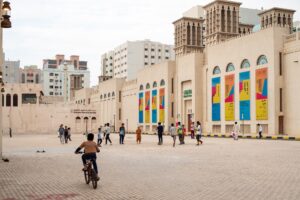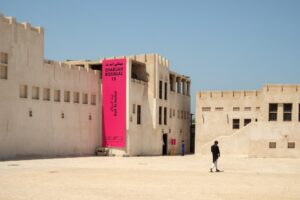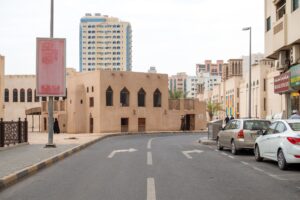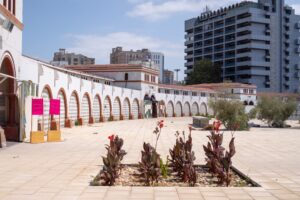For better or for worse, Lawrence’s dream came true, just a few kilometers to the east. Saudi united and so many efforts weren’t really needed: oil and the disinterest on the part of the British were enough to bless the birth of the UAE. The UAE is a federation of seven vastly different states. If, for example, the Emirate of Dubai aims to give a precise image of itself on a global level, that of Sharjah prefers to cultivate its traditions without noise. Sharjah, precisely, is also the capital of the emirate of the same name, as well as the protagonist of this brief reflection. The city is a former hideout for pirates disguised as pearl diggers. Its Emir, Sheikh Sultan III, is a historian whose goal over the years has become to demonstrate how unfounded these slanders are. Sheikh Hoor Al Quasimi, his daughter, in addition to being the director of the biennial he founded, is also the curator of this thirtieth edition dedicated to the critic and curator Okwui Enwezor.

Art Museum, Sharjah, exhibition venue, Sharjah Art Biennale 2023 , photo Beatrice Timillero
“Thinking Historically in the Present”, open until 11 June 2023, explores the similarities and differences of multiple post-colonial experiences around the world. It follows the Documenta model, accompanying the viewer to discover not only the careful artistic selection but the country itself. The itinerary begins in the Persian Gulf, with a tour of the coastal cities of Sharjah and Al Hamriyah, continues inland with a visit to Al Dhaid, and ends, near the Indian Ocean, with an exploration of the towns of Kalba and Khorfakkan.

Bait Al Serkal, Sharjah, exhibition venue, Sharjah Art Biennale 2023 , photo Beatrice Timillero
One feature that catches the eye with respect to this biennial is the selection of its exhibition spaces. Through the observation of the pavilions themselves, in fact, it is possible to trace, albeit summarily, the history of the town, accessing stories that would otherwise be lost. Kalba is representative in this sense: here it is possible to visit a former brutalist ice cream factory and an old kindergarten from the 70s. In both cases there is no precise exhibition itinerary, rather the invitation is to get lost inside the buildings. For example, the free exploration of the factory proved to be particularly exciting: the closed doors could house both spectacular site-specific works and old out-of-use control units, giving the visitor the feeling of being an Indiana Jones of industrial archeology.

Sharjah, city center overview, photo Beatrice Timillero
One of the most fascinating places in the exhibition is certainly Bait Al Serkal. Located in Sharjah, before evolving into a very refined art gallery it was the residence of the British commissioners, the home of the Al Quasimi dynasty and finally a maternity clinic. Beyond the beauty of the structure, a maze of stairs, corridors and rooms articulated around a lively central garden, the works presented here and their relevance reach a very high level. As with almost the entire Biennale, there are no works out of place, both in terms of their location (it seems impossible that most of the works were not specifically created) and in relation to the proposed theme. The most that can be said about some works is “they are not to my taste”, while remaining aware of their value in a context that is the result of extremely precise visual and syntactic choices.

Al Jubail Vegetable Market, exhibition venue, Sharjah Art Biennale 2023, photo Beatrice Timillero
Sharjah is not a tourist city. At most there is a Radisson Hotel which from afar looks abandoned. While the beaches of Dubai are already crowded, those of Sharjah are only seen by fishermen doing their best under the “no fishing” sign. There have been numerous expropriations to build the citadel of art and other exhibition pavilions, even the course of some roads has been diverted to make room for the numerous structures of the biennale. Although the square of the Art Museum is always populated, a question arises spontaneously: who is all this intended for? The inhabitants seem completely uninterested in the question, indeed, the impression is that two separate worlds coexist within the city: the places of art and those of life.

Ibrahim Mahama – “A Tale of Time/Purple Republic”, 2023, Kalba Ice Factory, Kalba, photo Beatrice Timillero
Furthermore, counting that almost all visitors are already highly motivated or work in the field, the influx is very small and marginally affects the economic well-being of the place. Whoever is building all this, as well as having the power, enjoys enormous privileges. However, despite the sublime work and a nepotism that, against our Italian conception, works very well, it is right to point out the particular dualism that is being created in this distant reality. Every utopia is built at the expense of something. It is fair to ask whether these sacrifices, imposed on a city that is alive and proud of its privacy, will lead to something good or if they will be relegated to being a very valid statement.
Beatrice Timillero
Info:
Sharjah Biennial 15
7/02/2023 – 11/06/2023
curated by Hoor Al Qasimi, Director of Sharjah Art Foundation
www.sharjahart.org/biennial-15

is a contemporary art magazine since 1980






NO COMMENT